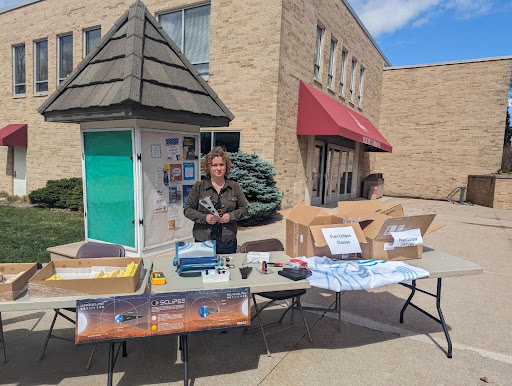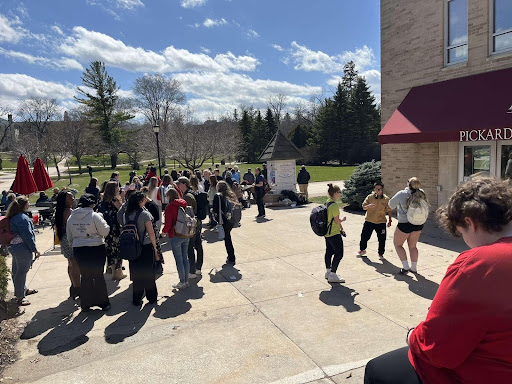By Miki Canak in College Days, Student Life on April 19, 2024
Ripon College’s Society of Physics Students gathers to distribute solar eclipse glasses and promote eclipse viewing safety
Students from Ripon College and Ripon community members gathered on April 8 on campus to experience a solar eclipse.

Professor Othon stands at the table outside of the commons, ready to hand out eclipse glasses to students. Photo Courtesy of Caitlin Marsch.
Members of Ripon College’s Society of Physics Students volunteered to distribute solar eclipse glasses and to encourage safe solar eclipse viewing.
Faculty and additional members of the Society of Physics students brought out materials and equipment in order to help visitors understand the science behind the eclipse. A few of these materials included solar projection telescopes, solar cells, and a solar oven.
“We had two solar projection telescopes that allowed us to see sunspots. Sunspots are dark patches that you see on the sun, and they are caused by changes in magnetic field,” Associate Professor of Physics Christina Othon said.
The solar projection telescopes were able to focus light from the sun, and they were set up in front of the table for the Society of Physics Students.
“You can think of the sun as a large plasma or fluid that rotates. Rotating charges create these magnetic fields,” Othon said.

Students gather to pick up eclipse glasses from Ripon College’s Society of Physics outside of the Commons. Photo Courtesy of Rickie Bailey.
Many community members and students gathered around to learn about the solar oven that had the ability to record high temperatures from the sun. Associate Professor of Physics Brett Barwick provided additional information about the use of the solar oven and solar projection telescopes during the event, which lasted from 11 a.m. until 2 p.m.
“The reason that I had a solar oven there was to think about the energy that we are able to collect from the sun. When people go out on a warm day, they can feel the sun rays on their skin, and they know that there is energy being carried. I wanted to show how much power there was in that, and I think that the solar oven is a great way to represent that,” Othon said.
The solar oven reached a temperature of about 430 degrees Fahrenheit.
Students also noticed crescent shadows that appeared on the ground from trees due to reflections of light.
“It was a mild day in Wisconsin with a lot of cloud cover. I think people were really surprised to see that you could bake a pizza using the sun’s rays on that type of day,” Othon said.
She said that her favorite part of the solar eclipse event was the conversations that she had with naturally curious people, including children who had a deep fascination with the topic.
“I love sharing my passion for science with others, and this was an event where people were coming to me because they were excited about science. I got to share my love, and it was an amazing experience,” Othon said.


